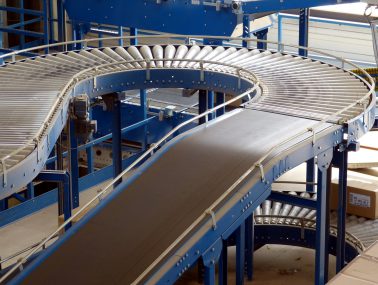Material Handling
 All manufacturing and logistics businesses need to properly organise material handling to ensure the smooth and effective running of daily operations. This includes the most efficient use of transporting and positioning equipment. By managing this properly, businesses develop ways of working that increase productivity, enhance workplace safety and reduce days lost through employee injury.
All manufacturing and logistics businesses need to properly organise material handling to ensure the smooth and effective running of daily operations. This includes the most efficient use of transporting and positioning equipment. By managing this properly, businesses develop ways of working that increase productivity, enhance workplace safety and reduce days lost through employee injury.
Material handling and positioning equipment is deployed to move material from one location to another, either within the manufacturing site or between the site and a vehicle. This includes, for example, moving goods between a loading dock and a storage area, or between workplaces. Positioning equipment, of which there are several different types, is utilised so material at a single location can be manipulated correctly.
Material handling normally calls for short distance movement; where material is in the confines of a building or between a building and a vehicle ready to transport it. Warehouses, manufacturing plants and retail stores all have materials that need to be transported by specific equipment that is designed to do the job efficiently and in safety. The use of the correct equipment also ensures the workflow is uninterrupted.
There are four main subcategories of material transportation:
- Conveyors and conveyor systems
- Cranes
- Industrial trucks, including pallet trucks
- Manual, where no equipment is used.
Each of these methods requires appropriate training and the installation of safety labels on the equipment involved.
Conveyors
Conveyor systems include:
- Belt conveyors
- Roller conveyors
- Modular belt conveyors
- Pallet conveyors.
Conveyor belts are used to transport bulk materials, such as food products and pharmaceuticals. These are shifted either in loose bulk form, using conveyor belts or elevators designed for moving large quantities, or in packaged form using rollers, hoppers or drums.
Conveyors are used when it’s necessary to move material frequently between fixed points. There needs to be sufficient flow volume so investment in a fixed conveyor can be justified.
Cranes
Cranes are a familiar feature on city skylines where large-scale construction work is being carried out, however, cranes also transport loads over variable paths, either horizontally or vertically, within a more restricted and often internal area.
They are mainly used when there is not enough flow of material to justify the use of a conveyor system. They provide more flexibility than conveyors as the loads handled can be more varied in terms of shape and weight.
Industrial trucks
Industrial trucks, such as pallet trucks, also move material over variable paths and in this case they are even more flexible than cranes or conveyors because they are not restricted in the area they can cover.
Machines that provide vertical movement, such as forklift trucks, can be highly maneuverable. Hand trucks are unpowered, requiring the operator to walk with the truck rather than riding on it as they would with a powered model.
Manual handling
When manual handling, employees move or handle materials by lifting, lowering, pulling, pushing, holding, carrying or restraining. This is an area where safety precautions and relevant training is essential. Manual handling is the most common cause of occupational fatigue, lower back injuries and lower back pain in musculoskeletal disorders.
As with all potentially hazardous workplace practices risk assessments must be carried out. This applies whether employees are using mechanised equipment or performing tasks manually. This not only protects the workforce from harm, it safeguards the business from legal action should there be an accident.
Risk factors
To avoid these problems in the workplace, businesses must be fully aware of the risk factors that may lead to or directly cause them. Where manual handling is common, these can include:
- Adverse working environments – for example too cold or too hot
- Bending and twisting
- Exerting too much force
- Frequent heavy lifting
- Long working hours with insufficient breaks
- Not acting on or receiving reports of symptoms quickly enough
- Psychosocial issues, such as lack of control, time pressures or excessive job demands
- Requirements to repeat jobs too quickly
- Working in uncomfortable positions.
Practical steps
Employers should ensure mechanical lifting and handling equipment is used when workers are dealing with heavy loads. This considerably reduces the risk of injury.
There are other practical steps employers can take to minimise risk, one of which is the correct labelling of loads likely to cause problems. If a load presents a possible risk of injury and it cannot be handled by lifting devices or the load cannot be split, it should be clearly labelled in terms of weight, and, if practicable, if there is a heavier side to the package this should be indicated.
Handlers should be taught techniques for gauging the amount of force needed, for example by rocking the load from side to side or applying force and then stopping, before they attempt a lift.
Investing in appropriate material handling equipment is money well spent. It reduces the risk of having to deal with the problems created when an employee is injured and reduces the amount of working days lost. Remember there is also the unpleasant possibility that a workplace injury might lead to criminal prosecution and civil action for damages if the necessary Health and Safety provisions were not in place.
